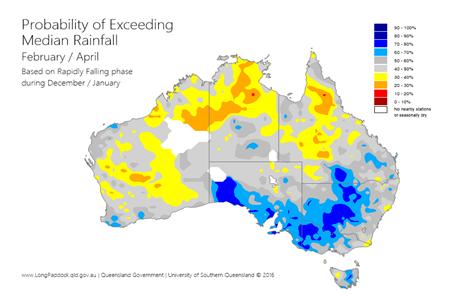Climate Outlook - February to April 2019 - Barkly Tablelands
Summary
- Rainfall forecast is likely to be below average for the rest of the season and temperatures are very likely to continue being above average.
- Bureau of Meteorology (BoM) have an El Niño Watch in place which suggests a 50 per cent chance of El Niño forming during the 2019 autumn/winter period (the United States have declared a weak El Niño). El Niño in winter can mean a late, dry wet season.
- The Madden-Julian Oscillation (MJO) has moved well away from Australia and conditions now indicate a break in the monsoon.
- The chance of exceeding median pasture growth is only 10-30% for most of the Barkly. This is due to a combination of past rainfall, soil moisture, predicted rain and temperatures.
- If pasture growth does occur in the coming month or two, it is unlikely to develop much bulk before the dry season. It is important that stressed pastures are not grazed heavily as this can lead to tussock death with a subsequent decline in long-term pasture condition and a reduced ability for pastures to respond in subsequent wet seasons.
Workshops and emails
Attending the Barkly Climate Workshops (see advertisement in this issue of Barkly Beef) and signing on to receive email updates with the NACP Climate Mate for the Barkly means you get some interesting information on the main climate drivers. Learning how El Niño, the Southern Oscillation Index (SOI) and the MJO work means that you have a better understanding of how forecasts are made and what that means to your business.
For example: We hear a lot about El Niño during winter, when it often has a strong impact on the southern winter rainfall zones. While El Niño doesn’t impact the Barkly during the dry season, it is often linked to a late start to the wet season. Currently, BoM is forecasting a 50% chance of El Niño forming this winter/dry season. If it does, this might mean a late start to the 2019/2020 wet season. This is definitely NOT a forecast and it is very important to note that skill for predicting El Niño during Autumn is low, however understanding how some of these climate drivers can affect your region might help when making long term management decisions.
This month’s featured climate driver
What is the Southern Oscillation Index (SOI)?
The SOI is a measure of the difference in atmospheric pressure between Darwin and Tahiti. It is an indicator of the formation of El Niño (negative SOI) and La Niña (positive SOI). Rather than a daily measurement, SOI is described as a trend over 30 days.
- Sustained positive SOI values (above +8) are linked with La Niña.
- Sustained negative SOI values (below -8) are linked with El Niño.
What does it mean for rain forecasts?
The map below shows the probability of getting more than the median rainfall for February to April. It is derived from a forecasting system utilising SOI phases. This map is produced using a statistical model which looks at data from many past years of records and makes a forecast for this season based on what happened in years where similar conditions were experienced.

What does it mean for the Barkly?
There is only a 30-40 per cent chance that the Barkly will receive more than the median rainfall for the three month total for February to April. So that means a 60-70 per cent chance that the total rainfall will be less than the median. It’s probably reasonable to plan on the dry weather continuing for the remainder of the season.
Managing grazing in dry conditions
Where conditions are expected to remain drier than usual and/or feed is likely to be impacted, now is a good time to start considering management options. Strategies that can be implemented include:
Radical weaning
- Involves weaning calves down to approximately 80kg. This greatly reduces the nutritional demand on the breeder, allowing her to maintain body condition longer into the dry season and potentially increasing her chances of re-conceiving next year.
- Reducing the nutritional demand also reduces grazing pressure which helps preserve pasture.
- Requires a comprehensive management plan for calves i.e. a good quality ration (specially formulated calf pellets), good quality roughage (hay or native pasture) and plenty of clean water.
Supplement and fodder
- Availability of hay and supplements may become limited; liaise with potential providers early.
- Dry season supplementation is only effective if animals have a body of feed in front of them, so careful pasture budgeting will be required.
Some useful websites with dry season management plans
There are some very specific checklists and online tools to help crunch numbers for decision making on the Meat Livestock Australia website.
The Future Beef website has lots of information. Search for this Future Beef website document for dry season management plans.
Give feedback about this page.
Share this page:
URL copied!